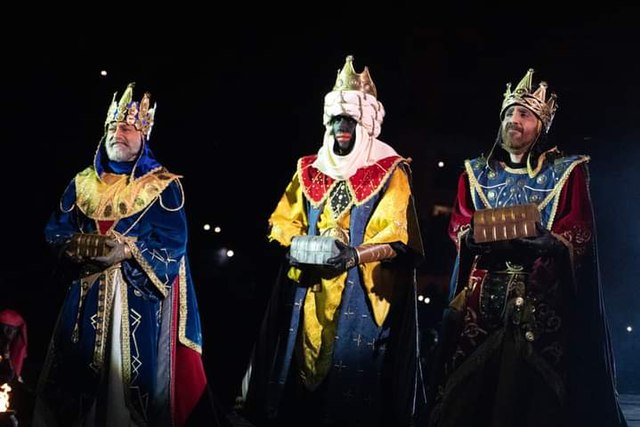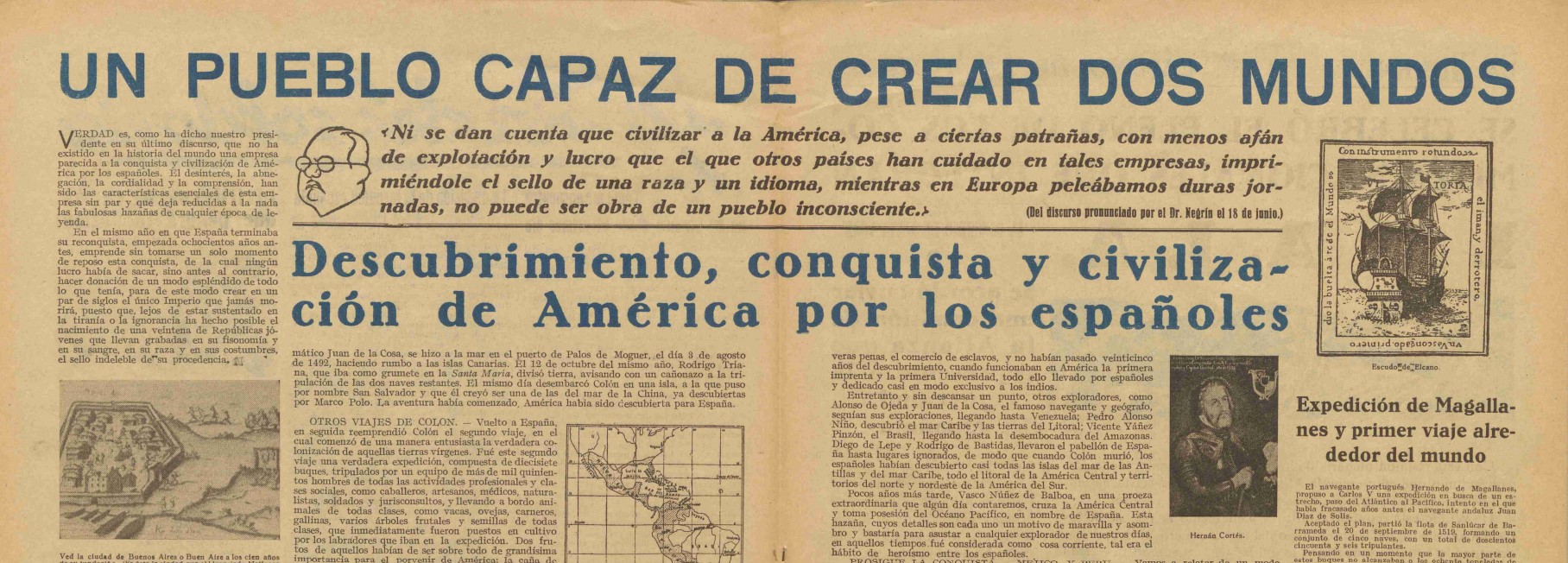Race and the Republic: the politics of race on the Spanish left
4 February 2025In his post, Henry Brown, lecturer in Modern European History here at Cardiff, explores antifascism and race in modern Spain
On the night of January 5th, 2024, along with most Catholic nations, Spain celebrated Epiphany (Noche de los Reyes Magos). The character of the festivities generally revolves around the “cabalgata” or procession of the Three Magi – Gaspar, Melchior, and Balthazar – who appear, accompanied by “helpers” on elaborate floats, throwing candies and toys to the crowd. In the city of Alcoi, King Balthazar appears each year with a blackened face and red lips accompanied by an army of “helpers” who are similarly painted, often wearing red loin cloths together with fezzes or turbans. During the processions in the Catalonian town of Igualada, nearly 800 participants of the “cabalgata” apply blackface while dressed in mocking orientalist costumes. This year, the deputy mayor of Madrid, a city that had banned the practice in 2015, was forced to apologise after a video emerged of a blackfaced Balthazar performing a mock West African accent to children during the celebrations. In light of my ongoing research into antifascism and race in modern Spain, these images disturbed me not only for their immediate content but because they revealed how uncritically pervasive these racial constructions remain.

Criticism of blackface has generally not been led by the traditionally antiracist forces of the left. Instead, the initiative has come from Afro-Spanish and antiracist advocacy groups, such as the SOS Racismo Federation and the Black African and Afro-descendant Community in Spain (CNAAE). In Alcoi, the local response, from both the left and the right, cis that these performances have nothing to do with race. Rather they are innocent manifestations of local traditions. In 2023, the socialist deputy mayor of the city, Jordi Valentí, denied that there was any ‘racist or slave component’ to the spectacle, instead Balthazar and his attendants were ‘magical’ characters beloved by children. Valentí is not the only socialist politician to have met these accusations of racism with incredulity. The regional president of the Spanish Socialist Party (PSOE), Borja Sanjuan Roca, denied that the abuse hurled at the Real Madrid striker Vinícius Júnior – which included cries of “monkey” – constituted racism on the part of the Valencian fans. Rather, the spectators were simply expressing frustration at the flamboyant antics of a player whom Sanjuan considered ‘a disgrace to football.’
Public declarations that ‘Spain is not racist, but there are racists in Spain’, bely the concerning reality that racial discrimination in the country is both pervasive and on the rise. In 2023, according to the Office for Democratic Institutions and Human Rights there were 856 recorded hate crimes motivated by racism and xenophobia, compared to 515 in 2019. Reports by the antiracism NGO, SOS Racismo, have revealed widespread discriminatory housing practices against ‘distinguishable’ foreigners while a United Nations working group described the Spanish police’s racial profiling of individuals of African descent as ‘endemic.’ There is also a rise in ‘harmful prejudices’ among younger generations, with one study finding around 25% consistently displaying broadly hostile or ambivalent attitudes to most forms of inclusivity. SOS Racismo have also signalled a broader lack of integration and engagement across government and civil society on issues relating to racism. This reflects a widely held assumption in Spain that refusing to recognise racial difference is the best antidote to racism.
All of this points to an obvious but seldom recognised conclusion that although Spain vocally describes itself as a post-racial society and celebrates its culturally diverse heritage, race and racialisation have been, and remain, embedded in Spanish politics and culture. This deracialised understanding of its own past was exemplified by the 1992 Seville Expo, an exhibition commemorating the fifth centennial of the “discovery” of the Americas. The administration of Felipe González – the first socialist premier since the Civil War of 1936-9 – hoped to use the exhibition to strengthen Spain’s cosmopolitan credentials to the European Community. Consequently, the Expo’s displays described the Spanish conquest of the Americas as a wondrous, mutually beneficial discovery and intermingling of peoples, laying the foundations for a multicultural and globalised world. Spain’s abuse of indigenous peoples through the encomienda system and lucrative participation in the transatlantic slave trade (which helped to finance Barcelona’s distinctive modernist architecture) were almost entirely omitted.

The presentation of Spain (and the Spanish) as a product of mixture and encounter goes back still further. Francisco Franco, who ruled Spain for forty years, showed unabashed admiration for Spain’s entangled past in the Americas and North Africa. He conceived this entangled past as the source of Spain’s racial greatness. In Franco’s eyes, the centuries of intermarriage with Romans, Visigoths, Moroccans, and Jews had allowed them to imbibe and combine the strengths of these diverse peoples, producing a “racial alloy” that was stronger for the mixture. It was no contradiction for the caudillo to extol the superiority of the Spanish race while continuing to make public use of soldiers recruited from Spanish North Africa, who even composed his ceremonial guard until 1956. In the eyes of Spain’s fascistoid regime, the two peoples were racial cousins whose destinies were entwined, to mutual benefit.
How then did Franco’s opponents, ie. Spain’s antifascists and the Republican regime he overturned, understand race? As my ongoing research illustrates, race was no less enmeshed in the worldviews of the socialists, communists and anarchists who united to defend the Republic during Spain’s three-year Civil War (1936-9). The revolutionary antifascist militias which formed spontaneously in the summer of 1936 eagerly appropriated the symbols of other “oppressed races” around the world. A battalion formed of socialist workers named themselves the ‘Abyssinian Lions’ in tribute to the Ethiopian resistance to the ongoing Italian occupation. While recognising Mexico’s continued support for the Spanish Republic, the anarchists of Aragon identified themselves with the struggle of that Republic’s indigenous population: ‘The Aragonese,’ ran one newspaper headline, ‘are the indios (ie. Indians) of Spain due to their simpleness, energy, and tenacious love for the truth.’
As the war drew on and the calls for political unity grew louder, the leaders of the Republic increasingly appealed to Spain’s inherent greatness. The antifascists, it was claimed, were defending not just a state but culture itself. ‘We fight for Spain,’ declared the communist leader, Jesús Hernández, ‘and for all that it represents in human civilisation: its traditions, its artistic treasures, its land, its past and future.’ Franco and the fascists, with their indiscriminate aerial bombardments, were seen as the negation of enlightened civilisation. ‘While we strive to save everything that is of artistic value,’ one Republican officer wrote to his comrades, ‘the fascists destroy monuments … selling off paintings and reducing buildings, museums, and libraries to rubble…Truly this, and only this, can be expected of them given that they represent the negation of everything that has the smallest link to culture.’
But this laundry list of contributions to civilisation was not confined to the paintings of the Prado Museum or the horseshoe arches of Córdoba’s Mosque-Cathedral. It also included the conquest and “civilising” of the Americas. The Republic’s socialist Prime Minister, Juan Negrín, who effectively led the antifascist war effort in Spain from May 1937 onwards, proudly spoke of Spain’s role in the ‘civilising of America … imprinting on it the mark of a race and a language.’ The soldiers of the Republic were the new conquistadors since they were also ‘men of the people’ whose deeds spoke to ‘the qualities of a great race.’
In this light, the North African troops fighting for Franco were not seen as their distant kin, but the embodiment of fascist barbarism. Unconfirmed (and wildly sensationalised) reports of sexual violence against Republican women by these moros inflamed this conviction. Republican propaganda instructed its soldiers that they were defending western civilisation by defending white femininity from the savage racial other. The central newspaper of the Republican Army, Ejército Popular, instructed its soldiers to ‘care for your rifle[s]’ in order to avert fascist terror, to protect the lands of the peasantry, to stop Spain from becoming an Italo-German colony and ‘to prevent the defiling of our women by the Moors.’
Ideas about race are not an inexplicable irruption that only requires confrontation when images of Balthazar and his helpers cause a stir on social media. As my research suggests, they are embedded across the spectrum of Spain’s politics and throughout its cultural sphere. Race and racialisation have explicitly and implicitly driven political projects of anarchists, socialists and communists throughout the twentieth century. That these groups also possess tangible histories of transnational solidarity – having fought shoulder-to-shoulder with the International Brigades for three years – does not lessen the significance of this observation. Rather this puzzling convergence is one that invites explanation.
- American history
- Central and East European
- Current Projects
- Digital History
- Early modern history
- East Asian History
- Enlightenment
- Enviromental history
- European history
- Events
- History@Cardiff Blog
- Intellectual History
- Medieval history
- Middle East
- Modern history
- New publications
- News
- North Africa
- Politics and diplomacy
- Research Ethics
- Russian History
- Seminar
- Social history of medicine
- Teaching
- The Crusades
- Uncategorised
- Welsh History
- Pétain’s Silence
- Talking Politics in the Seventeenth Century
- Reflections on POWs on the 80th anniversary of the Second World War – views from a dissertation student
- The Long Life of Dic Siôn Dafydd and his ‘children’
- Collaboration across the pond: uniting histories of religious toleration in the American Revolution and European Enlightenment